Discover the ancient secrets behind the construction of the pyramids in Egypt. Explore theories, workforce insights, architectural precision, and innovative construction methods used by skilled workers over 4,500 years ago. Unravel one of history's greatest mysteries
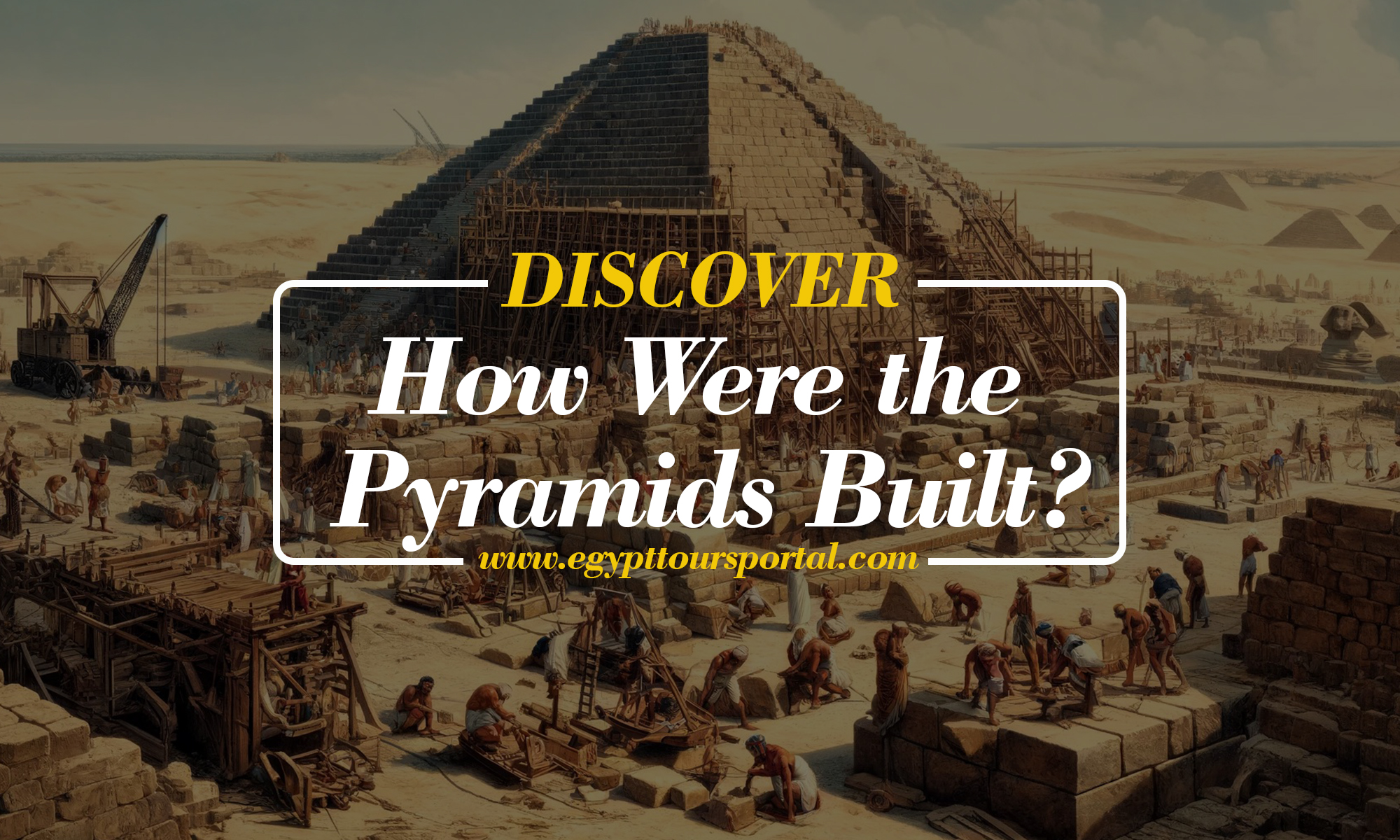
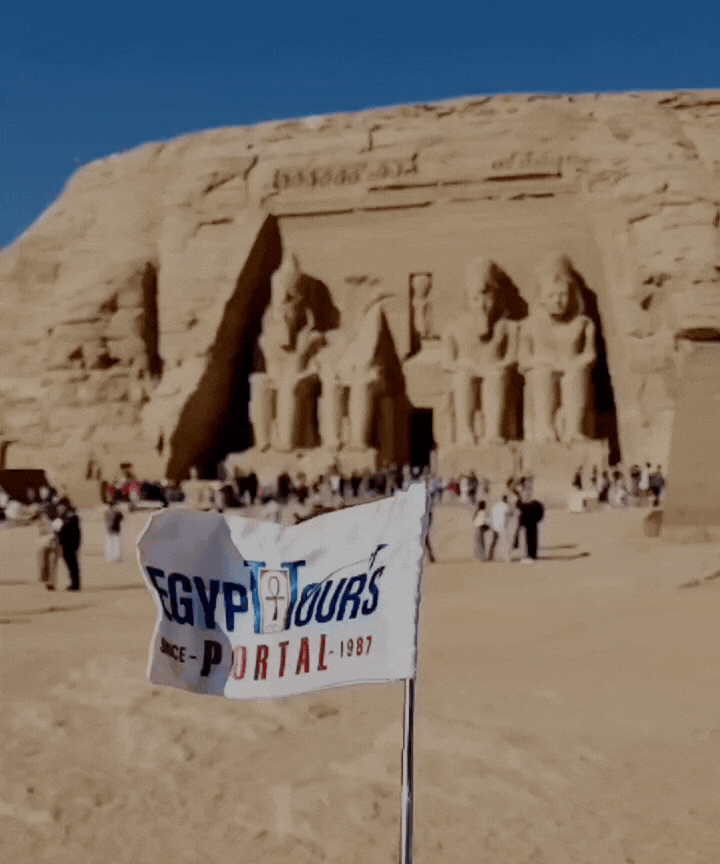
How the Pyramids were built is a highly debated question that has wandered the minds of scholars from all over the world for thousands of years. The main goal of this article is to offer every traveler all the information and facts about how the ancient Egyptians were able to build the pyramids. This article was written by a very knowledgeable and professional team of Egyptologists, tour guides, travel consultants, and historians who know all the details about how the pyramids of Egypt were built.
One of history's most ancient puzzles is the construction of the pyramids; over and over again, through the course of history, many nations, scholars, and scientists have asked the question, "How were the pyramids built?". 4,500 years ago, Giza Pyramids were constructed to immortalize the legacy of the ancient Egyptian civilization for many generations to come, it also was able to offer insight into the life aspects of the ancient Egyptians, from religious to agricultural practices, through the magical wall illustrations of the pyramids.
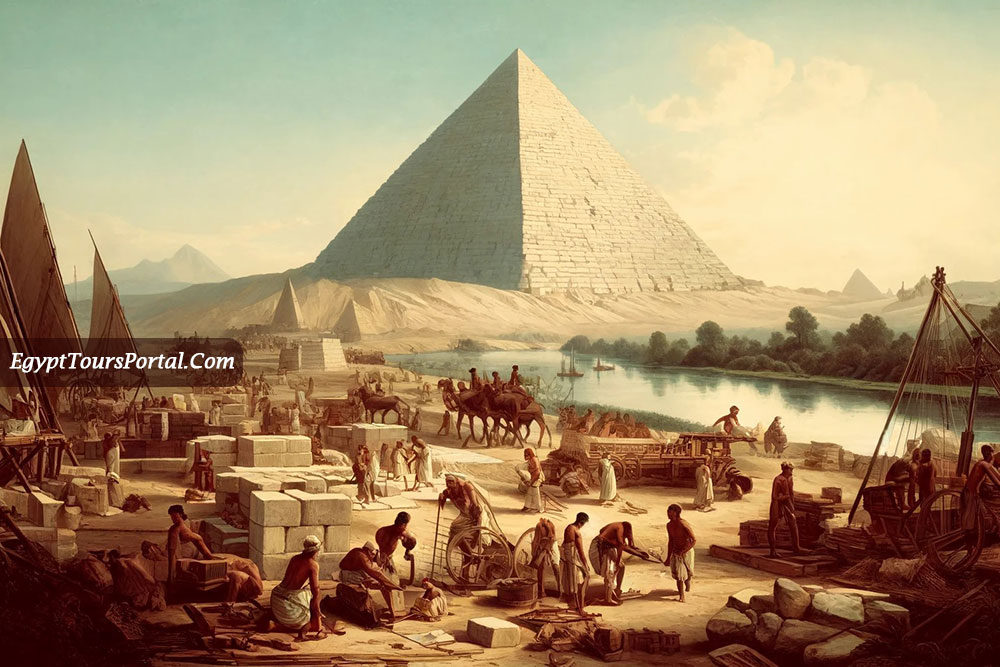
How the pyramids were built is the world's oldest puzzle, and many highly educated scholars have given many controversial theories and hypotheses. The most generally believed theory is that the massive limestone blocks were carved from the quarries in Giza using copper and bronze chisels, then dragged and lifted into the accurate position. The manner of the movement and placement of these stone blocks and the size of the workforce are under great debate even today.
Egyptian Pyramid construction techniques are one of history's greatest mysteries. The great pyramids of Giza stand as the ultimate puzzle and the best source of information; it was constructed over 4,500 years ago with over 2 million stones and took 20 to 30 years to make, but many have argued over the question "How?". There are two common theories that many believe have played a part in constructing the pyramids: the ramp theory and the water shaft theory, plus the limestone concrete theory. The complexity of the construction and level of accuracy and magnitude became the source of a number of pseudoscientific theories as means of providing any sort of explanation.
The Ramp Theory is considered by far the most accepted by the Egyptology community, who believe that the pyramid was made by sheer will and human power, using a massive workforce and incredible intelligence to transport the stones across the desert through sleds and ropes. They used wet sand to drag the stones to reduce the fraction and make the dragging process easier.
Many images and carvings can be seen on all the temples. When the stones arrived after being dragged across the desert, the ancient Egyptians used a series of ramps to drag the stones all the way to the top. The ancient Egyptians either used a straight ramp up one side or a spiraling ramp wrapped around the pyramid, but many believe a combination of the two was used. Levers were used once a significant height was reached, and ramps were no longer useful and needed. A number of documents and images were discovered to support the fact that sleds were made.
The Water Shaft Theory states that the stones were transported through a water canal that was built all the way to the construction sites, which allowed the stones to float across the waters and made the transportation process very easy. The floats were made of cedar wood or inflated animal skins wrapped in papyrus, then attached to the stones, which would allow the stones to be pulled from the shore. Then, the floating stones are led to the canals all the way to a moat, which is found all around the construction site, and the stone blocks are allowed to be taken to any place needed. Four water pipelines were used to float the blocks up the hill, and they were extended when the pyramid grew in size.
The gates controlled how the stone blocks moved all the way to the top of the moat. A pool of water on the top of the construction site, "Water Elevators" allowed for more floating and positioning without any dragging or actual heavy lifting. There is no concrete or valid evidence of this theory, but many traces of water throughout the structure and imperfections across the middle of all four sides have been identified to support this theory.
There are many theories about the construction of the pyramids floating all over the internet, such as the limestone concrete theory, which states that soft limestone with a high content of kaolinite was quarried in the wadi on the southern side of the Giza Plateau. The clay-wet limestone concrete would be carried and packed in reusable wooden molds, and then, in a few days, the blocks would be turned into stones.
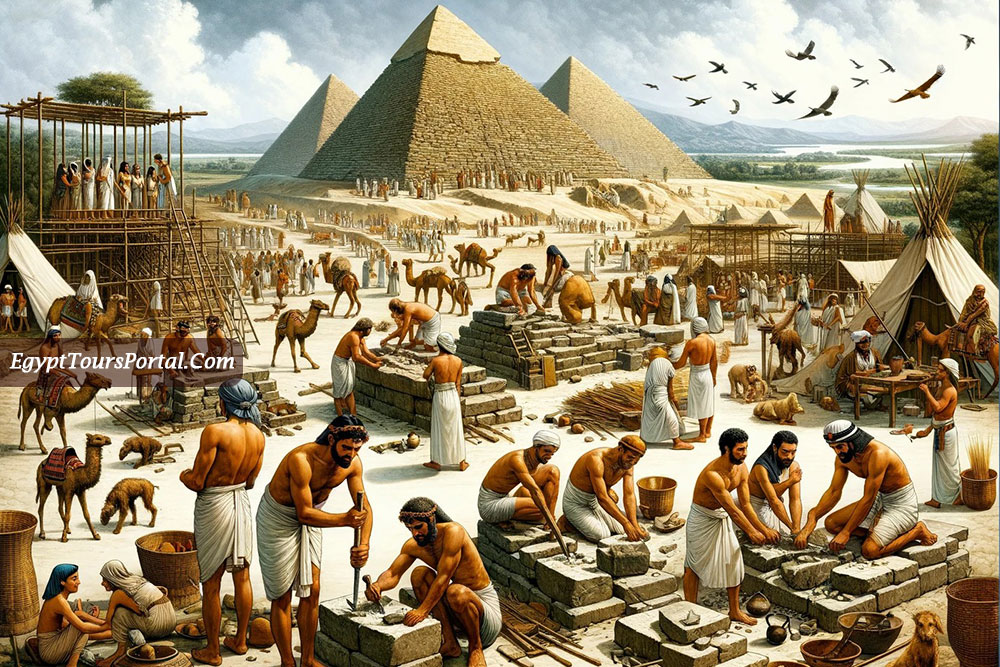
The techniques used in constructing the Egyptian pyramids have baffled historians and scientists for countless years. The pyramids are the subject of many controversial hypotheses. The general theory is based on the belief that the huge stones were carved from the quarries using copper chisels and then dragged and lifted into position. However, the method concerning the movement and placement of these stones was highly disputed.
The form of the workforce was under a huge debate as it was believed that the pyramids were constructed using slave labor, but after research published in 1990, it turned out that the pyramids were built by "Tens of Thousands of Free Skilled Workers" who lived and buried near the great pyramid and worked for a salary, a wage of ten loaves of bread or a jug of beer per day or a form of tax payment until the construction was completed. They used hammers, chisels, and levers capable of handling the stones. The workforce was highly organized and managed to the highest level.
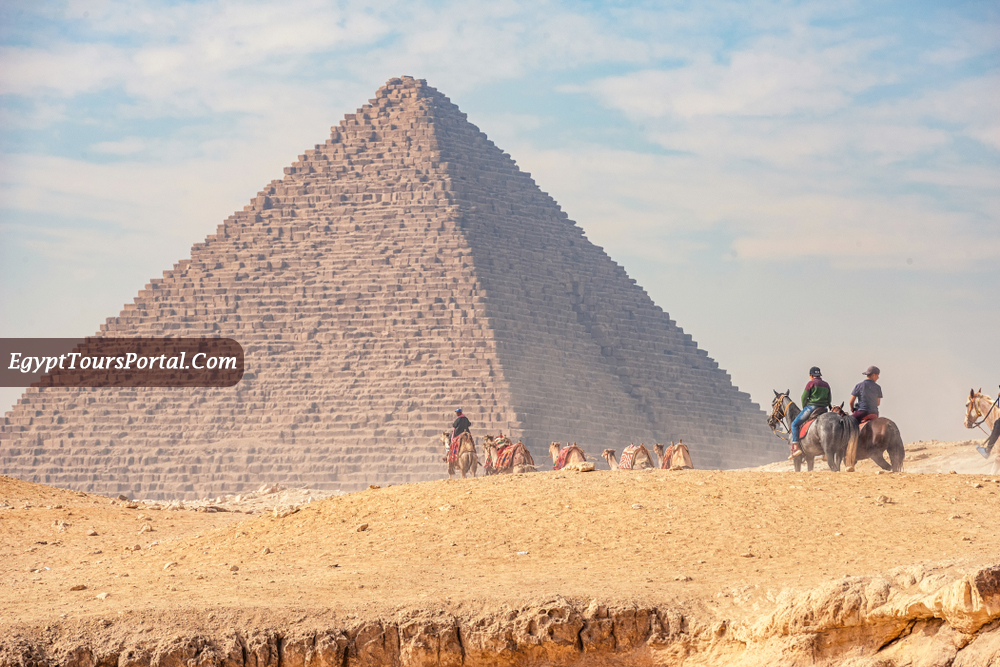
The most important element in constructing a pyramid is choosing the right location. The pyramids were constructed on the west side of the Nile River, where the sunset was believed to be, which was believed to be where the dead entered the underworld. The location also needed to be on higher ground to avoid the danger of flooding at the time of the Nile's inundation.
The location must be in close proximity to the Nile River and on a firm rock base capable of supporting the massive weight of any Pyramids without cracking or showing signs of structural weakness. More importantly, it must be within close reach of the current capital.

The pyramids were constructed using locally quarried limestone, which was the main material of choice. A higher quality of limestone quarried near modern Cairo was used for the outer casing. Granite, quarried near Aswan, was used in the construction of architectural elements of the roofs and the burial chamber, as well as in the outer casing, like the King Menkaure Pyramid. The workers began their work by preparing a strong foundation by removing the loose sand from the rock base, which was made completely flat.
The flat base was accomplished by building low mud walls all around the base and cutting the channels in a grid pattern over the surface. The channels were then filled with water, and the level at which the water reached was marked. After the water was drained, all the sticking-out rocks were removed, and any void was filled with stones to make the surface perfectly flat.
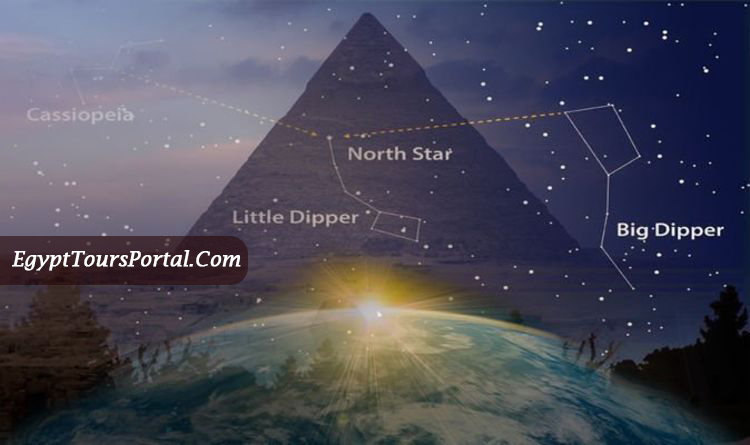
The ancient Egyptians were highly advanced in the field of astronomy, and each side of the pyramid was designed to face one of the cardinal points. The ancient Egyptian builders observed the rising and setting of the northern star on the horizon, which explains why they began by establishing the true north first, then the rest of the other directions.
They were able to make all four sides exactly the same length and in the right perfect corners. They bisected the angle, thus obtaining north and south lines; they also used their instruments to draw the right angles and find the east and the west angles.
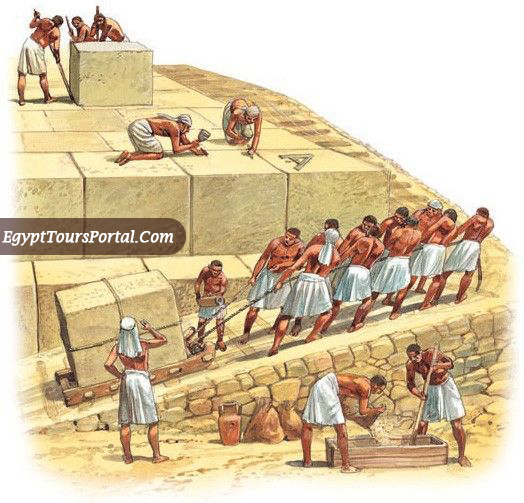
One of the biggest mysteries surrounding the construction of the pyramid is the process by which the massive limestone blocks weighing 2.2 tons were moved across the desert. A wall painting on a tomb dating to 1900 BC depicts 170 men dragging a huge state using ropes attached to a sled, and in front of it are men pouring water over the sand in order to reduce friction and make it easier to operate the sled. The ancient Egyptians understood that adding water to the sand increased its stiffness to drag the sleds more easily across the surface.
They calculated the amount of water necessary to reduce the friction depending on the type of sand and the optimal amount of waterfalls between 2% and 5% of the complete value of the sand. This discovery is highly important as it not only explains how the blocks were moved but also helps the researchers understand the behavior of other granular materials like coal or even asphalt or concrete.

One of the most acknowledged theories on what method was used to raise the blocks among the Egyptologists is ramps. The Greek historian shows in his writings the use of levers to raise the blocks from one level to the next. As the pyramids grew in size, so did the ramps to the point where the ramp had to be as huge as the pyramid.
Internal ramps were also used as the grand gallery is believed to have acted as a trolley guide for counterbalance weights. There is also a theory that states that a form of limestone concrete was cast in wooden molds, and then it would transform from a wet to a hard substance after undergoing a chemical reaction. The method of the pyramids is completely shrouded with mystery, and many theories are still open to discussion.
Egypt has always been the home of the impossible; within the heart of the country in Cairo lies the miraculous Pyramids of Giza, where the impossible is yet to be explained. The cities of Egypt like Giza, Cairo, Aswan, and Luxor are the purest reflection of how the ancient Egyptians' vision was extraordinary, so we offer you the chance to enjoy a marvelous trip to Egypt with the Nile river cruise. Also, our Cairo day tours are the best way to book your trip if you are in Cairo. Check our Egypt day tours if you are in any of Egypt's top destinations to arrange your tours.
Cairo Stopover Tour for American Travelers Cairo stopover tour is the ultimate porta...
Tour Location: Cairo/Giza...
Cairo and Giza Day Tour for Ameican Travelers Day tour in Cairo and the Pyramids is ...
Tour Location: Cairo/Giza...
Day Trip to Pyramids from Cairo for American Travelers Day trip to the Pyramids from...
Tour Location: Giza...
Day Trip from Luxor to Cairo by Plane For American Travelers Day trip from Luxor to ...
Tour Location: Cairo...
The ancient Egyptians constructed the pyramids as tombs for their royal members like kings, or pharaohs. Egyptian beliefs state that when the pharaoh died, his spirit or soul remained essential in the afterlife. In addition to the pharaoh's mummy, the pyramids contained all the items that the pharaoh would need like food, furniture, and others in the afterlife.
Ancient Egyptian Pyramids were built for religious purposes, a passage to the afterlife. The ancient Egyptians were one of the first civilizations on earth to believe in an afterlife and act on it. They believed that a second self-called the ka lived within every human being and when the physical body demised, the ka enjoyed eternal life.
What makes how the pyramid was built a complete mystery is the complete lack of information when it comes to the construction techniques, as despite all the extensive research and archaeological discoveries, there is still no consensus on the exact methods and tools employed by the ancient Egyptians in constructing these colossal structures. Moving and precisely placing millions of massive stones must have taken sophisticated techniques that haven't been fully documented for over 4500 years, which makes the entire subject a complete enigma. All that was left with are a number of theories and hypotheses that try to explain the creation of this wonder that would be near-impossible to build in the current state and time.
The pyramids of Egypt were built over a very long period, ranging from the 26th century BCE to the 17th century BCE. The Great Pyramid of Giza is considered to be the largest pyramid ever, which is estimated to have been built around 2560 BC, which makes it 4500 years, while the oldest pyramid to be built is the step pyramid of Djoser, which was completed in 2650 BC.
Despite our understanding of ancient Egyptian architecture and engineering, which has completely advanced, unfortunately, we do not have any clear answer; we have a series of theories that could hold the answer. Over time, researchers and Egyptologists were able to come up with a number of important facts as all the limestone and granite were extracted from nearby quarries using copper chisels and hammers, plus they likely used sleds lubricated with water or fat to move the stones on ramps constructed of earth and debris. Also, Levers, rollers, ramps, and inclines are believed to have been used to maneuver the stones into place. There is also evidence that the Nile River played a role in transporting the stones through the upper and lower Egypt. Also, evidence discovered states that the builders were not slaves but paid laborers with specialized skills in quarrying, transporting, and setting stones.
The theory that the pyramids were built by slave labor has been debunked by archaeological evidence, thus proving to be more skilled workers, builders, and artisans who were likely organized into labor groups for specific periods of service. Archaeological excavations of the workers' village near the Giza complex provide evidence of this, as well as insights into their living conditions and treatment. Skeletons unearthed at the site reveal fractures that were carefully treated, indicating a level of care for the workers' well-being. Also, the workers consumed a diet richer in protein than the general population, suggesting they were better nourished and received better healthcare, which was inconsistent with the harsh conditions expected of slaves. Hieroglyphic inscriptions in the worker’s village depict organized workforces with supervisors and skilled laborers, not slaves.
The construction of the pyramid is a very highly debated subject as everything remains a subject of debate. The workforce of the Great Pyramid is about 400000 paid workers who functioned in different shifts. Workers extracted all the limestone and granite needed for the pyramids from nearby quarries, employing copper chisels and hammers. To transport the massive stones, they likely utilized Sledges lubricated with water or fat, moving them along ramps made of earth and debris. Levers, rollers, ramps, and inclines were employed to maneuver the stones into position. Evidence suggests that the Nile River also played a crucial role in transporting the stones across Upper and Lower Egypt. Advance tools like plumb bobs and sighting instruments were made to ensure all alignment and angles were perfect. Each pyramid may have employed different techniques across the spanning of time which depended on the location and the time period.
The Pyramids were built during the Old Kingdom period of Ancient Egypt (2700–2200 BC) primarily as monumental tombs for the pharaohs. The construction likely involved a combination of skilled labor, advanced planning, careful measurement, skilled craftsmanship, and innovative engineering techniques.
The absolute symmetry and precision of the great pyramids of Egypt are due to incredible advanced engineering and architectural brilliance. Archaeologists and historians continue to study the available evidence in an attempt to unravel the mystery behind its mastery and perfect state beyond the boundaries of time. Stonemasons possessed advanced skills in cutting and shaping stones. They likely used tools like plumb bobs and sighting instruments to ensure alignment and angles. The pyramid was built layer by layer, allowing for continuous adjustments and corrections.
The pyramids were built between 2650 BC and 2400 BC to be the final resting place for the pharaohs of the 3rd and 4th dynasties. Construction involved a combination of skilled labor, advanced planning, and innovative engineering techniques.
Archaeological evidence suggests the pyramid workforce comprised skilled laborers, artisans, and engineers who were organized into teams and employed for specific periods, receiving compensation and provisions for their labor.
Yes, overwhelming evidence confirms that humans built the Egyptian pyramids, which is based on the fact that Extensive excavations around the pyramids have unearthed tools, implements, and worker settlements, all consistent with human construction techniques. Inscriptions and artwork depict the building process, showcasing human laborers involved in quarrying, transporting, and positioning stones. Analysis of worker cemeteries near the pyramids reveals signs of good health and proper care, incompatible with the harsh conditions expected of slaves often portrayed in fictionalized accounts. The pyramids were built during well-documented periods of Egyptian history, with established societal structures and technological advancements capable of supporting such large-scale projects.
The construction of the Pyramids involved skilled craftsmen, laborers, engineers, builders, and architects who worked under the direction of the pharaohs and their appointed officials.
No, the Pyramids were built thousands of years before the advent of Islam. They were constructed during ancient Egypt's Old Kingdom period, long before the rise of Islam in the region. The oldest pyramids date back to the 26th century BCE, belonging to the Old Kingdom of Egypt, long predating any Islamic presence in the region.
The notion of aliens building the pyramids is a popularized myth with no scientific backing. This theory often stems from misconceptions about the pyramids' age, complexity, the capabilities of ancient civilizations, and the stupidity of unintellectual folks.
Yes, the pyramids were built significantly before Jesus Christ. The construction of the pyramids spanned from the 26th century BCE to the 17th century BCE, whereas Jesus is estimated to have lived between 4 BC and 30 AD. This translates to a gap of several millennia between the pyramid-building era and the life of Jesus.
Throughout Egypt's history, there have been many attempts where different kinds of natural disasters like earthquakes, wind erosion, and sandstorms have caused some damage over time. Plus, in the Fatimid and Mamluk periods, limestone and white granite were removed from the pyramids over time to create all the great Islamic monuments found all over Cairo.
While the Pyramids have remained intact for thousands of years, many believe that they are indestructible, but this is not the case. Natural disasters, such as earthquakes or flooding, as well as human activities, could potentially damage the structures over time, which explains all the efforts to preserve and protect the Pyramids to ensure their survival for future generations.
The entire country of Egypt deserve to be explored with its every heavenly detail but there are places that must be seen before any other such as the breathtaking Hurghada's red sea, The wonders of Cairo the pyramids of Giza, the great sphinx, the Egyptian Museum, Khan El Khalili Bazaar, the wonders of Luxor like Valley of the Kings, Karnak & Hatshepsut temple and the wonders of Aswan such as Abu Simbel temples, Philea temple, Unfinished obelisk and The Wonders of Alexandria like Qaitbat Citadel, Pompey's Pillar and Alexandria Library. Read more about the best places to visit in Egypt.
If you want to apply for a Visa On Arrival that lasts for 30 days then you should be one of the eligible countries, have a valid passport with at least 6 months remaining and pay 25$ USD in cash, as for the E-Visa for 30 day you should have a valid passport for at least 8 months, complete the online application, pay the e-visa fee then print the e-visa to later be presented to the airport border guard. You could also be one of the lucky ones who can obtain a free visa for 90 days. Read more about Egypt travel visa.
Egypt has a variety of delicious cuisines but we recommend “Ful & Ta’meya (Fava Beans and Falafel)”, Mulukhiya, “Koshary”, a traditional Egyptian pasta dish, and Kebab & Kofta, the Egyptian traditional meat dish.
The best time to travel to Egypt is during the winter from September to April as the climate becomes a little tropical accompanied by a magical atmosphere of warm weather with a winter breeze. You will be notified in the week of your trip if the Climate is unsafe and if any changes have been made.
You should pack everything you could ever need in a small bag so you could move easily between your destinations.
We have been creating the finest vacations for more than 20 years around the most majestic destinations in Egypt. Our staff consists of the best operators, guides and drivers who dedicate all of their time & effort to make you have the perfect vacation. All of our tours are customized by Travel, Financial & Time consultants to fit your every possible need during your vacation. It doesn't go without saying that your safety and comfort are our main priority and all of our resources will be directed to provide the finest atmosphere until you return home.
You will feel safe in Egypt as the current atmosphere of the country is quite peaceful after the government took powerful measures like restructuring the entire tourist police to include all the important and tourist attractions in Egypt. Read more about is it safe to travel to Egypt.
Wear whatever feels right and comfortable. It is advised to wear something light and comfortable footwear like a closed-toe shoe to sustain the terrain of Egypt. Put on sun block during your time in Egypt in the summer to protect yourself from the sun.
The best activity is by far boarding a Nile Cruise between Luxor and Aswan or Vise Versa. Witness the beauty of Egypt from a hot balloon or a plane and try all the delicious Egyptian cuisines and drinks plus shopping in old Cairo. Explore the allure and wonders of the red sea in the magical city resorts of Egypt like Hurghada and many more by diving and snorkeling in the marine life or Hurghada. Behold the mesmerizing western desert by a safari trip under the heavenly Egyptian skies.
There are a lot of public holidays in Egypt too many to count either religious or nation, the most important festivals are the holy month of Ramadan which ends with Eid Al Fitr, Christmas and new years eve. Read more about festivals & publich holidays in Egypt.
Egypt is considered to be one of the most liberal Islamic countries but it has become a little bit conservative in the last couple of decades so it is advised to avoid showing your chest, shoulders or legs below the knees.
Arabic is the official language and Most Egyptians, who live in the cities, speak or understand English or at least some English words or phrases. Fewer Egyptians can speak French, Italian, Spanish, and German. Professional tour guides, who work in the tourism sector, are equipped to handle visitors who cannot speak Arabic and they will speak enough English and other languages to fulfill the needs of all our clients.
The fastest way is a car, of course, a taxi. If you are in Cairo ride a white taxi to move faster or you could board the fastest way of transportation in Egypt metro if the roads are in rush hour.
The temperature in Egypt ranges from 37c to 14 c. Summer in Egypt is somehow hot but sometimes it becomes cold at night and winter is cool and mild. The average of low temperatures vary from 9.5 °C in the wintertime to 23 °C in the summertime and the average high temperatures vary from 17 °C in the wintertime to 32 °C in the summertime. The temperature is moderate all along the coasts.
It is the home of everything a traveler might be looking for from amazing historical sites dating to more than 4000 years to enchanting city resorts & beaches. You will live the vacation you deserve as Egypt has everything you could possibly imagine.









